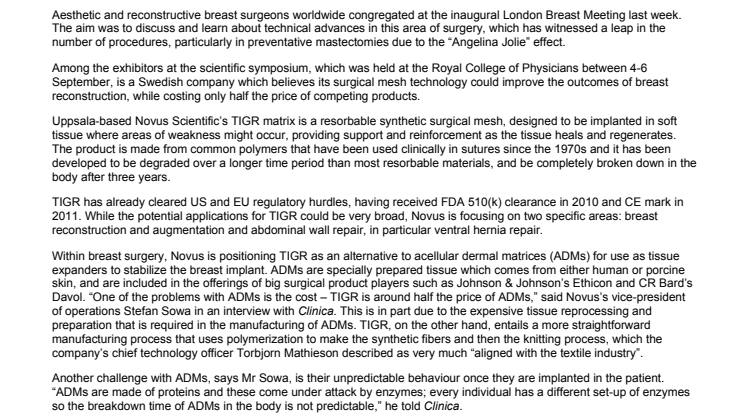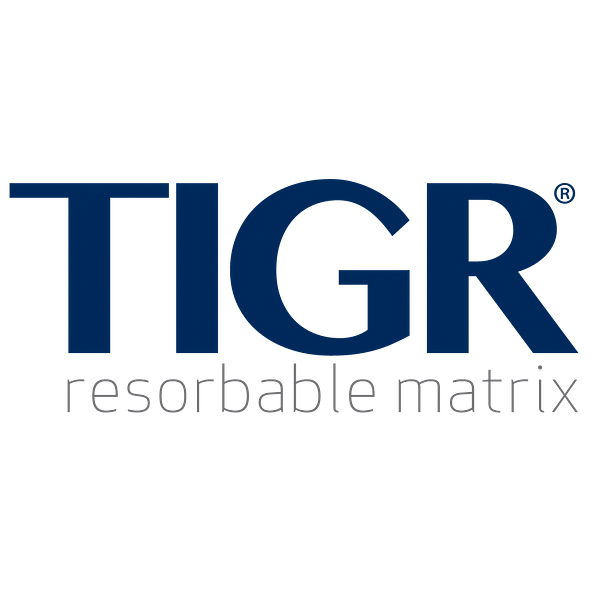News -
Clinica INTERVIEW: Novus out to prove TIGR’s strength in soft tissue regeneration
Aesthetic and reconstructive breast surgeons worldwide congregated at the inaugural London Breast Meeting last week.The aim was to discuss and learn about technical advances in this area of surgery, which has witnessed a leap in thenumber of procedures, particularly in preventative mastectomies due to the “Angelina Jolie” effect.
Among the exhibitors at the scientific symposium, which was held at the Royal College of Physicians between 4-6September, is a Swedish company which believes its surgical mesh technology could improve the outcomes of breastreconstruction, while costing only half the price of competing products.
Uppsala-based Novus Scientific’s TIGR matrix is a resorbable synthetic surgical mesh, designed to be implanted in softtissue where areas of weakness might occur, providing support and reinforcement as the tissue heals and regenerates.The product is made from common polymers that have been used clinically in sutures since the 1970s and it has beendeveloped to be degraded over a longer time period than most resorbable materials, and be completely broken down in thebody after three years.
TIGR has already cleared US and EU regulatory hurdles, having received FDA 510(k) clearance in 2010 and CE mark in2011. While the potential applications for TIGR could be very broad, Novus is focusing on two specific areas: breast reconstruction and augmentation and abdominal wall repair, in particular ventral hernia repair.
Within breast surgery, Novus is positioning TIGR as an alternative to acellular dermal matrices (ADMs) for use as tissue expanders to stabilize the breast implant. ADMs are specially prepared tissue which comes from either human or porcineskin, and are included in the offerings of big surgical product players such as Johnson & Johnson’s Ethicon and CR Bard’sDavol. “One of the problems with ADMs is the cost – TIGR is around half the price of ADMs,” said Novus’s vice-presidentof operations Stefan Sowa in an interview with Clinica. This is in part due to the expensive tissue reprocessing andpreparation that is required in the manufacturing of ADMs. TIGR, on the other hand, entails a more straight forward manufacturing process that uses polymerization to make the synthetic fibers and then the knitting process, which the company’s chief technology officer Torbjorn Mathieson described as very much “aligned with the textile industry”.
Another challenge with ADMs, says Mr Sowa, is their unpredictable behaviour once they are implanted in the patient.“ADMs are made of proteins and these come under attack by enzymes; every individual has a different set-up of enzymesso the breakdown time of ADMs in the body is not predictable,” he told Clinica.
The material that makes up TIGR, on the other hand, is designed to degrade over a certain time period. Indeed, TIGR ismade up of two different fibers, each with their own degradation timelines.
This enables the mesh to change its mechanical properties over time – from starting out quite rigid to becoming more flexible over time – in order to provide the optimal support throughout the different phases of the tissue healing andregeneration process.
Of the two fibers that make up TIGR, one fiber has a fast resorption rate, losing its mechanical strength after two weeks and becoming completely resorbed into the body in four months. This fiber is key to maintaining extra stability require dduring the first critical week after implantation. During this time, the mesh remains firmly anchored at the implant site as new tissue starts to regenerate at the wound site. The second fiber has a longer degradation time, but remains strong and flexible to allow cells that are attaching themselves to the mesh to “feel the load situation” and remodel themselves into functional connective tissue. This second fiber loses its mechanical strength after nine months and is rebsorbed after three years.
The specific structure of TIGR – the way which the fibers are knitted together – is also designed to encourage better tissue healing and regeneration. The specific porosity of the matrix allows strength and cell deposition and regrowth, says Mr. Sowa, and because the fibers are not braided or twisted, as with many other types of surgical mesh, this more “open”design reduces the likelihood of microbes being trapped between the fibers and the risk of wound infection.
A preclinical study in sheep, published in 2011, compared the performance of TIGR against a permanent polypropylenemesh over a three year period. It found that as the TIGR gradually degraded, it was replaced by newly formed collagen matrix with an increasing ration of collagen type I/III, “indicating a continuous remodelling of the collagen towards a strong connective tissue”, the study authors wrote. On the other hand, the control permanent mesh “provoked a typical chronicinflammation” that persisted over the three-year study period.
More specific to breast reconstruction, a small retrospective study published last year evaluated the performance of TIGR as an alternative to ADMs when used in select breast surgery cases where ADMs may have failed. While it was not a direct comparison between the two products, the study’s authors concluded that TIGR shows “potential” when used as temporary reinforcement in patients undergoing breast reconstruction or breast surgery revisions and in primary aesthetic procedures, and it appears to be a viable alternative to the use of ADMs.
These findings from the preclinical and clinical study, together with feedback from doctors who have used the TIGR – a total of 2,400 patients have been treated with the surgical mesh to date – points to the product having a lower complication rate than existing alternatives. Mr Sowa added that feedback from surgeons has highlighted that they’ve found TIGR’seasy handling properties also to be a major advantage.
Apart from ADMs and permanent meshes, another product that is probably a more direct competitor to TIGR in soft tissue reinforcement is Allergan’s Seri silk-based surgical scaffold. Again, Novus believes TIGR has the cost advantage, with Seribeing 2-3 times more expensive. It also has different handling characteristics, with TIGR being soft and pliable and Seribeing rough and less pliable. Additionally, while there has been some history of high inflammatory response and adverseevents associated with Seri, Novus claims there have been none such reports with TIGR.
The Swedish company’s priority is to now build up clinical evidence to support commercialization of TIGR in the US andEurope for both breast surgery and also for abdominal wall repair. Novus is now forging various relationships with hospitals, including Vanderbilt University Medical Center in the US, that will use TIGR in hernia and breast surgeries. It is also taking part in a UK study of medical devices used in breast surgery called iBRA. The study is designed to analyseboth aesthetic and reconstructive surgeries, led in part by Dr Sue Refsum of Belfast hospital, and will compare andcontrast patient outcomes.T
The company will be commercializing TIGR through distribution partners in the US and Europe. As for whether it is open to negotiations with the big boys like J&J and CR Bard, who might be looking for a product such as TIGR to add to their portfolio, the firm remains tight-lipped, indicating this might be a topic for the future.
Please refer to the PDF document to see the story as it appeared in Clinica Medtech.
Topics
- Health, Health Care, Pharmaceuticals
Categories
- tina tan
- new product
- medical devices
- mesh
- plastic surgery
- surgery
- breast reconstruction
- interview
- novus scientific
- tigr matrix

